ZHCSBF4B July 2013 – September 2015 ADS42JB46
PRODUCTION DATA.
- 1 特性
- 2 应用
- 3 说明
- 4 修订历史记录
- 5 Device Comparison Table
- 6 Pin Configuration and Functions
-
7 Specifications
- 7.1 Absolute Maximum Ratings
- 7.2 ESD Ratings
- 7.3 Recommended Operating Conditions
- 7.4 Thermal Information
- 7.5 Electrical Characteristics: ADS42JB46
- 7.6 Electrical Characteristics: General
- 7.7 Timing Characteristics
- 7.8 Digital Characteristics
- 7.9 Reset Timing
- 7.10 Serial Interface Timing
- 7.11 Typical Characteristics: ADS42JB46
- 7.12 Typical Characteristics: Contour
-
8 Detailed Description
- 8.1 Overview
- 8.2 Functional Block Diagram
- 8.3 Feature Description
- 8.4 Device Functional Modes
- 8.5 Programming
- 8.6
Register Maps
- 8.6.1 Summary of Serial Interface Registers
- 8.6.2
Description of Serial Interface Registers
- 8.6.2.1 Register Address 06
- 8.6.2.2 Register Address 07
- 8.6.2.3 Register Address 08
- 8.6.2.4 Register Address 0B
- 8.6.2.5 Register Address 0C
- 8.6.2.6 Register Address 0D
- 8.6.2.7 Register Address 0E
- 8.6.2.8 Register Address 0F
- 8.6.2.9 Register Address 10
- 8.6.2.10 Register Address 11
- 8.6.2.11 Register Address 12
- 8.6.2.12 Register Address 13
- 8.6.2.13 Register Address 1F
- 8.6.2.14 Register Address 26
- 8.6.2.15 Register Address 27
- 8.6.2.16 Register Address 2B
- 8.6.2.17 Register Address 2C
- 8.6.2.18 Register Address 2D
- 8.6.2.19 Register Address 30
- 8.6.2.20 Register Address 36
- 8.6.2.21 Register Address 37
- 8.6.2.22 Register Address 38
- 9 Application and Implementation
- 10Power Supply Recommendations
- 11Layout
- 12器件和文档支持
- 13机械、封装和可订购信息
7 Specifications
7.1 Absolute Maximum Ratings
Over operating free-air temperature range, unless otherwise noted.(1)| MIN | MAX | UNIT | ||
|---|---|---|---|---|
| Supply voltage | AVDD3V | –0.3 | 3.6 | V |
| AVDD | –0.3 | 2.1 | V | |
| DRVDD | –0.3 | 2.1 | V | |
| IOVDD | –0.3 | 2.1 | V | |
| Voltage between AGND and DGND | –0.3 | 0.3 | V | |
| Voltage applied to input pins | INAP, INBP, INAM, INBM | –0.3 | 3 | V |
| CLKINP, CLKINM | –0.3 | minimum (2.1, AVDD + 0.3) | V | |
| SYNC~P, SYNC~M | –0.3 | minimum (2.1, AVDD + 0.3) | V | |
| SYSREFP, SYSREFM | –0.3 | minimum (2.1, AVDD + 0.3) | V | |
| SCLK, SEN, SDATA, RESET, PDN_GBL, CTRL1, CTRL2, STBY, MODE | –0.3 | 3.9 | V | |
| Temperature | Operating free-air, TA | –40 | 85 | °C |
| Operating junction, TJ | 125 | °C | ||
| Storage, Tstg | –65 | 150 | °C | |
(1) Stresses beyond those listed under Absolute Maximum Ratings may cause permanent damage to the device. These are stress ratings only, which do not imply functional operation of the device at these or any other conditions beyond those indicated under Recommended Operating Conditions. Exposure to absolute-maximum-rated conditions for extended periods may affect device reliability.
7.2 ESD Ratings
| VALUE | UNIT | |||
|---|---|---|---|---|
| V(ESD) | Electrostatic discharge | Human body model (HBM), per ANSI/ESDA/JEDEC JS-001(1) | ±2000 | V |
(1) JEDEC document JEP155 states that 500-V HBM allows safe manufacturing with a standard ESD control process.
7.3 Recommended Operating Conditions(3)
Over operating free-air temperature range, unless otherwise noted.| MIN | NOM | MAX | UNIT | |||
|---|---|---|---|---|---|---|
| SUPPLIES | ||||||
| AVDD | Analog supply voltage | 1.7 | 1.8 | 1.9 | V | |
| AVDD3V | Analog buffer supply voltage | 3.15 | 3.3 | 3.45 | V | |
| DRVDD | Digital supply voltage | 1.7 | 1.8 | 1.9 | V | |
| IOVDD | Output buffer supply voltage | 1.7 | 1.8 | 1.9 | V | |
| ANALOG INPUTS | ||||||
| VID | Differential input voltage range | Default after reset | 2 | VPP | ||
| Register programmable(1) | 2.5 | VPP | ||||
| VICR | Input common-mode voltage | VCM ± 0.025 | V | |||
| Maximum analog input frequency with 2.5-VPP input amplitude | 250 | MHz | ||||
| Maximum analog input frequency with 2-VPP input amplitude | 400 | MHz | ||||
| CLOCK INPUT | ||||||
| Input clock sample rate | 10x mode | 60 | 160 | MSPS | ||
| 20x mode | 40 | 156.25 | MSPS | |||
| Input clock amplitude differential (VCLKP – VCLKM) |
Sine wave, ac-coupled | 0.3(2) | 1.5 | VPP | ||
| LVPECL, ac-coupled | 1.6 | VPP | ||||
| LVDS, ac-coupled | 0.7 | VPP | ||||
| LVCMOS, single-ended, ac-coupled | 1.5 | V | ||||
| Input clock duty cycle | 35% | 50% | 65% | |||
| DIGITAL OUTPUTS | ||||||
| CLOAD | Maximum external load capacitance from each output pin to DRGND | 3.3 | pF | |||
| RLOAD | Single-ended load resistance | +50 | Ω | |||
| TA | Operating free-air temperature | –40 | 85 | °C | ||
(1) For details, refer to the Digital Gain section.
(3) To reset the device for the first time after power-up, only use the RESET pin. Refer to the Register Initialization section.
7.4 Thermal Information
| THERMAL METRIC(1) | ADS42JB46 | UNIT | |
|---|---|---|---|
| RGC (QFN) | |||
| 64 PINS | |||
| RθJA | Junction-to-ambient thermal resistance | 22.9 | °C/W |
| RθJC(top) | Junction-to-case (top) thermal resistance | 7.1 | °C/W |
| RθJB | Junction-to-board thermal resistance | 2.5 | °C/W |
| ψJT | Junction-to-top characterization parameter | 0.1 | °C/W |
| ψJB | Junction-to-board characterization parameter | 2.5 | °C/W |
| RθJC(bot) | Junction-to-case (bottom) thermal resistance | 0.2 | °C/W |
(1) 有关传统和新热指标的更多信息,请参见《半导体和 IC 封装热指标》应用报告,SPRA953。
7.5 Electrical Characteristics: ADS42JB46
Typical values are at TA = 25°C, AVDD = 1.8 V, AVDD3V = 3.3 V, DRVDD = 1.8 V, IOVDD = 1.8 V, 50% clock duty cycle, –1-dBFS differential analog input, and sampling clock rate = 160 MSPS, unless otherwise noted. Minimum and maximum values are across the full temperature range of TMIN = –40°C to TMAX = 85°C, AVDD = 1.8 V, AVDD3V = 3.3 V, DRVDD = 1.8 V, and IOVDD = 1.8 V.| PARAMETER | TEST CONDITIONS | 2-VPP FULL-SCALE | 2.5-VPP FULL-SCALE | UNIT | |||||
|---|---|---|---|---|---|---|---|---|---|
| MIN | TYP | MAX | MIN | TYP | MAX | ||||
| SNR | Signal-to-noise ratio | fIN = 10 MHz | 73.7 | 75.2 | dBFS | ||||
| fIN = 70 MHz | 73.5 | 74.9 | dBFS | ||||||
| fIN = 170 MHz | 69.5 | 72.9 | 74.2 | dBFS | |||||
| fIN = 230 MHz | 72.3 | 73.3 | dBFS | ||||||
| SINAD | Signal-to-noise and distortion ratio | fIN = 10 MHz | 73.5 | 75.1 | dBFS | ||||
| fIN = 70 MHz | 73.3 | 74.7 | dBFS | ||||||
| fIN = 170 MHz | 68.5 | 72.8 | 73.6 | dBFS | |||||
| fIN = 230 MHz | 72 | 72.8 | dBFS | ||||||
| SFDR | Spurious-free dynamic range (including second and third harmonic distortion) |
fIN = 10 MHz | 96 | 92 | dBc | ||||
| fIN = 70 MHz | 94 | 90 | dBc | ||||||
| fIN = 170 MHz | 79 | 90 | 84 | dBc | |||||
| fIN = 230 MHz | 86 | 83 | dBc | ||||||
| THD | Total harmonic distortion | fIN = 10 MHz | 93 | 90 | dBc | ||||
| fIN = 70 MHz | 91 | 88 | dBc | ||||||
| fIN = 170 MHz | 76 | 87 | 82 | dBc | |||||
| fIN = 230 MHz | 84 | 81 | dBc | ||||||
| HD2 | 2nd-order harmonic distortion | fIN = 10 MHz | 96 | 95 | dBc | ||||
| fIN = 70 MHz | 94 | 90 | dBc | ||||||
| fIN = 170 MHz | 79 | 92 | 89 | dBc | |||||
| fIN = 230 MHz | 88 | 86 | dBc | ||||||
| HD3 | 3rd-order harmonic distortion | fIN = 10 MHz | 97 | 92 | dBc | ||||
| fIN = 70 MHz | 96 | 94 | dBc | ||||||
| fIN = 170 MHz | 79 | 90 | 84 | dBc | |||||
| fIN = 230 MHz | 86 | 83 | dBc | ||||||
| Worst spur (other than second and third harmonics) |
fIN = 10 MHz | 102 | 101 | dBc | |||||
| fIN = 70 MHz | 102 | 100 | dBc | ||||||
| fIN = 170 MHz | 87 | 100 | 95 | dBc | |||||
| fIN = 230 MHz | 98 | 92 | dBc | ||||||
| IMD | Two-tone intermodulation distortion | f1 = 46 MHz, f2 = 50 MHz, each tone at –7 dBFS |
97 | 95 | dBFS | ||||
| f1 = 185 MHz, f2 = 190 MHz, each tone at –7 dBFS |
90 | 89 | dBFS | ||||||
| Crosstalk | 20-MHz, full-scale signal on channel under observation; 170-MHz, full-scale signal on other channel |
100 | 100 | dB | |||||
| Input overload recovery | Recovery to within 1% (of full-scale) for 6-dB overload with sine-wave input | 1 | 1 | Clock cycle | |||||
| PSRR | AC power-supply rejection ratio | For a 90-mVPP signal on AVDD supply, up to 10 MHz | > 40 | > 40 | dB | ||||
| ENOB | Effective number of bits | fIN = 170 MHz | 11.8 | 12 | LSBs | ||||
| DNL | Differential nonlinearity | fIN = 170 MHz | ±0.4 | ±0.5 | LSBs | ||||
| INL | Integrated nonlinearity | fIN = 170 MHz | ±0.75 | ±3 | ±0.9 | LSBs | |||
7.6 Electrical Characteristics: General
Typical values are at 25°C, AVDD = 1.8 V, AVDD3V = 3.3 V, DRVDD = 1.8 V, IOVDD = 1.8 V, 50% clock duty cycle, –1-dBFS differential analog input, , and sampling clock rate = 160 MSPS unless otherwise noted. Minimum and maximum values are across the full temperature range: TMIN = –40°C to TMAX = 85°C, AVDD = 1.8 V, AVDD3V = 3.3 V, DRVDD = 1.8 V, and IOVDD = 1.8 V.| PARAMETER | TEST CONDITIONS | MIN | TYP | MAX | UNIT | |
|---|---|---|---|---|---|---|
| ANALOG INPUTS | ||||||
| VID | Differential input voltage range | Default (after reset) | 2 | VPP | ||
| Register programmed(1) | 2.5 | VPP | ||||
| Differential input resistance (at 170 MHz) | 1.2 | kΩ | ||||
| Differential input capacitance (at 170 MHz) | 4 | pF | ||||
| Analog input bandwidth | With 50-Ω source impedance and 50-Ω termination | 900 | MHz | |||
| VCM | Common-mode output voltage | 1.9 | V | |||
| VCM output current capability | 10 | mA | ||||
| DC ACCURACY | ||||||
| Offset error | –20 | 20 | mV | |||
| EGREF | Gain error as a result of internal reference inaccuracy alone | –2 | 2 | %FS | ||
| EGCHAN | Gain error of channel alone | –5 | %FS | |||
| Temperature coefficient of EGCHAN | 0.01 | Δ%/°C | ||||
| POWER SUPPLY | ||||||
| IAVDD | Analog supply current | 90 | 130 | mA | ||
| IAVDD3V | Analog buffer supply current | 234 | 330 | mA | ||
| IDRVDD | Digital supply current | 174 | 207 | mA | ||
| IOVDD | Output buffer supply current | 50-Ω external termination from pin to IOVDD, fIN = 2.5 MHz, 10x mode | 61 | 100 | mA | |
| Analog power | 162 | mW | ||||
| Analog buffer power | 772 | mW | ||||
| Digital power | 313 | mW | ||||
| Power consumption by output buffer | 50-Ω external termination from pin to IOVDD, fIN = 2.5 MHz, 10x mode | 109 | mW | |||
| Total power | 1.36 | 1.64 | W | |||
| Global power-down | 160 | mW | ||||
(1) Refer to the Serial Interface section.
7.7 Timing Characteristics
Typical values are at 25°C, AVDD = 1.8 V, AVDD3V = 3.3 V, DRVDD = 1.8 V, IOVDD = 1.8 V, 50% clock duty cycle, –1-dBFS differential analog input, and sampling clock rate = 160 MSPS, unless otherwise noted. Minimum and maximum values are across the full temperature range of TMIN = –40°C to TMAX = 85°C, AVDD = 1.8 V, AVDD3V = 3.3 V, DRVDD = 1.8 V, and IOVDD = 1.8 V. See Figure 3.| PARAMETER | TEST CONDITIONS | MIN | TYP | MAX | UNIT | |||
|---|---|---|---|---|---|---|---|---|
| SAMPLE TIMING CHARACTERISTICS | ||||||||
| Aperture delay | 0.4 | 0.7 | 1.1 | ns | ||||
| Aperture delay matching | Between two channels on the same device | ±70 | ps | |||||
| Between two devices at the same temperature and supply voltage | ±150 | ps | ||||||
| Aperture jitter | 85 | fS rms | ||||||
| Wake-up time | Time to valid data after exiting STANDBY mode | 50 | 200 | µs | ||||
| Time to valid data after exiting global power-down | 250 | 1000 | µs | |||||
| tSU_SYNC~ | Setup time for SYNC~ | Referenced to input clock rising edge | 400 | ps | ||||
| tH_SYNC~ | Hold time for SYNC~ | Referenced to input clock rising edge | 100 | ps | ||||
| tSU_SYSREF | Setup time for SYSREF | Referenced to input clock rising edge | 400 | ps | ||||
| tH_SYSREF | Hold time for SYSREF | Referenced to input clock rising edge | 100 | ps | ||||
| CML OUTPUT TIMING CHARACTERISTICS | ||||||||
| Unit interval | 320 | 1667 | ps | |||||
| Serial output data rate | 3.125 | Gbps | ||||||
| TJitter | Total jitter | 1.6 Gbps (10x mode, fS = 160 MSPS) | 0.28 | P-PUI | ||||
| 3.125 Gbps (20x mode, fS = 156.25 MSPS) | 0.3 | P-PUI | ||||||
| tR, tF | Data rise time, data fall time |
Rise and fall times are measured from 20% to 80%, differential output waveform, 600 Mbps ≤ bit rate ≤ 3.125 Gbps |
105 | ps | ||||
7.8 Digital Characteristics
The DC specifications refer to the condition where the digital outputs are not switching, but are permanently at a valid logic level 0 or 1. AVDD = 1.8 V, AVDD3V = 3.3 V, DRVDD = 1.8 V, and IOVDD = 1.8 V, unless otherwise noted.| PARAMETER | TEST CONDITIONS | MIN | TYP | MAX | UNIT | |
|---|---|---|---|---|---|---|
| DIGITAL INPUTS (RESET, SCLK, SEN, SDATA, PDN_GBL, STBY, CTRL1, CTRL2, MODE)(1) | ||||||
| VIH | High-level input voltage | All digital inputs support 1.8-V and 3.3-V logic levels |
1.2 | V | ||
| VIL | Low-level input voltage | All digital inputs support 1.8-V and 3.3-V logic levels |
0.4 | V | ||
| IIH | High-level input current | SEN | 0 | µA | ||
| RESET, SCLK, SDATA, PDN_GBL, STBY, CTRL1, CTRL2, MODE | 10 | µA | ||||
| IIL | Low-level input current | SEN | 10 | µA | ||
| RESET, SCLK, SDATA, PDN_GBL, STBY, CTRL1, CTRL2, MODE | 0 | µA | ||||
| DIGITAL INPUTS (SYNC~P, SYNC~M, SYSREFP, SYSREFM) | ||||||
| VIH | High-level input voltage | 1.3 | V | |||
| VIL | Low-level input voltage | 0.5 | V | |||
| VCM_DIG | Input common-mode voltage | 0.9 | V | |||
| DIGITAL OUTPUTS (SDOUT, OVRA, OVRB) | ||||||
| VOH | High-level output voltage | DRVDD – 0.1 | DRVDD | V | ||
| VOL | Low-level output voltage | 0.1 | V | |||
| DIGITAL OUTPUTS (JESD204B Interface: DA[0,1], DB[0,1])(2) | ||||||
| VOH | High-level output voltage | IOVDD | V | |||
| VOL | Low-level output voltage | IOVDD – 0.4 | V | |||
| |VOD| | Output differential voltage | 0.4 | V | |||
| VOCM | Output common-mode voltage | IOVDD – 0.2 | V | |||
| Transmitter short-circuit current | Transmitter terminals shorted to any voltage between –0.25 V and 1.45 V | –100 | 100 | mA | ||
| Single-ended output impedance | 50 | Ω | ||||
| COUT | Output capacitance | Output capacitance inside the device, from either output to ground |
2 | pF | ||
(1) The RESET, SCLK, SDATA, PDN_GBL, STBY, CTRL1, CTRL2, and MODE pins have a 150-kΩ (typical) internal pulldown resistor to ground. The SEN pin has a 150-kΩ (typical) pullup resistor to AVDD.
(2) 50-Ω, single-ended, external termination to IOVDD.
7.9 Reset Timing (1)
| PARAMETER | TEST CONDITIONS | MIN | TYP | MAX | UNIT | |
|---|---|---|---|---|---|---|
| t1 | Power-on delay | Delay from AVDD and DRVDD power-up to active RESET pulse | 1 | ms | ||
| t2 | Reset pulse width | Active RESET signal pulse width | 10 | ns | ||
| 1 | µs | |||||
| t3 | Register write delay | Delay from RESET disable to SEN active | 100 | ns | ||
(1) Typical values are at 25°C and minimum and maximum values are across the full temperature range of TMIN = –40°C to TMAX = 85°C, unless otherwise noted.
7.10 Serial Interface Timing(1)
| PARAMETER | MIN | TYP | MAX | UNIT | |
|---|---|---|---|---|---|
| fSCLK | SCLK frequency (equal to 1 / tSCLK) | > dc | 20 | MHz | |
| tSLOADS | SEN to SCLK setup time | 25 | ns | ||
| tSLOADH | SCLK to SEN hold time | 25 | ns | ||
| tDSU | SDIO setup time | 25 | ns | ||
| tDH | SDIO hold time | 25 | ns | ||
(1) Typical values are at 25°C, minimum and maximum values are across the full temperature range of TMIN = –40°C to TMAX = 85°C, AVDD3V = 3.3 V, and AVDD = DRVDD = IOVDD = 1.8 V, unless otherwise noted.
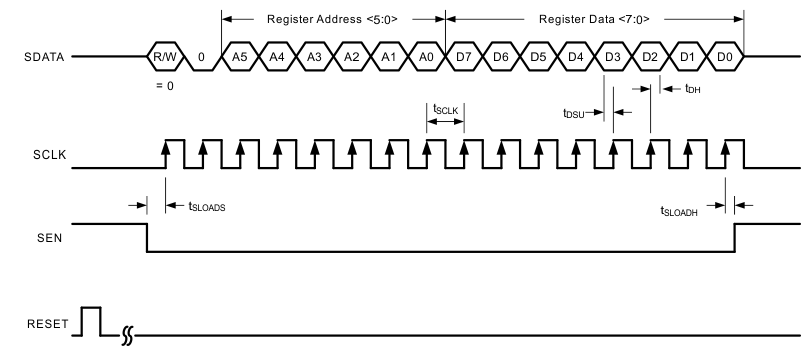 Figure 1. Serial Register Write Timing Diagram
Figure 1. Serial Register Write Timing Diagram
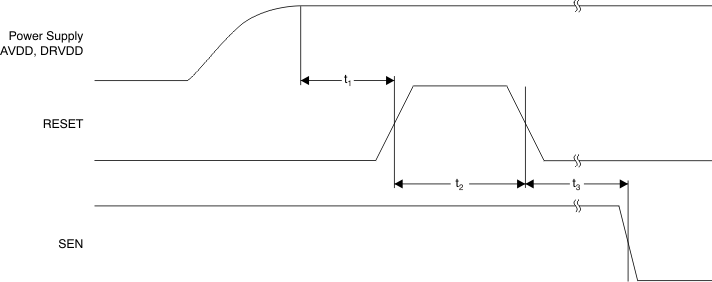
NOTE: After power-up, the internal registers must be initialized to their default values through a hardware reset by applying a high pulse on the RESET pin.
Figure 2. Reset Timing Diagram
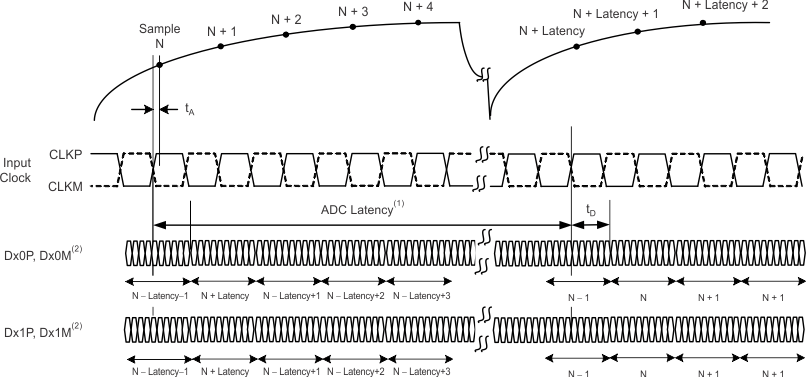
1. Overall latency = ADC latency + tD.
2. x = A for channel A and B for channel B.
Figure 3. ADC Latency
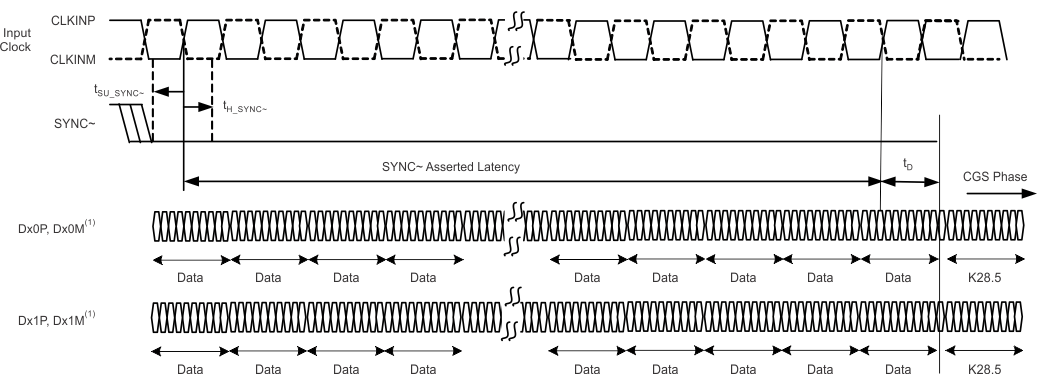
1. x = A for channel A and B for channel B.
Figure 4. SYNC~ Latency in CGS Phase (Two-Lane Mode)
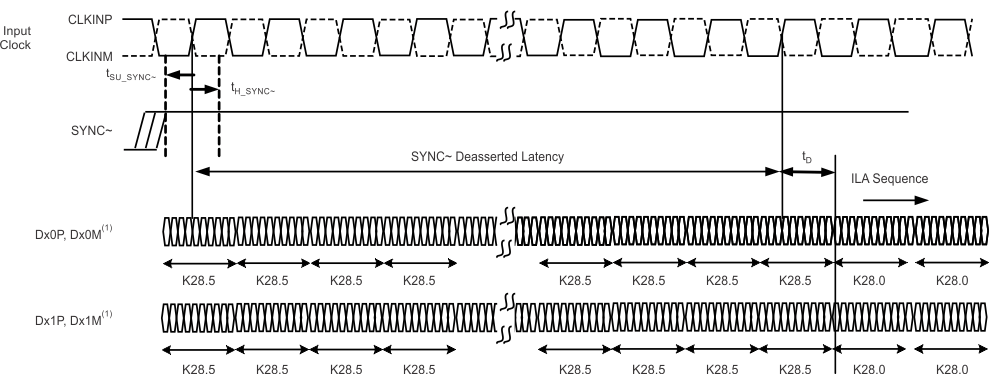
1. x = A for channel A and B for channel B.
Figure 5. SYNC~ Latency in ILAS Phase (Two-Lane Mode)
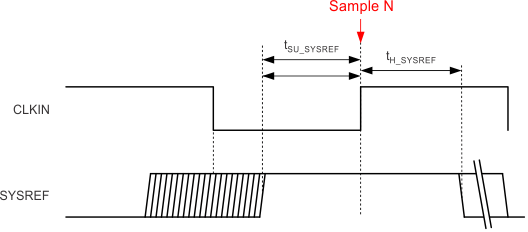 Figure 6. SYSREF Timing (Subclass 1)
Figure 6. SYSREF Timing (Subclass 1)
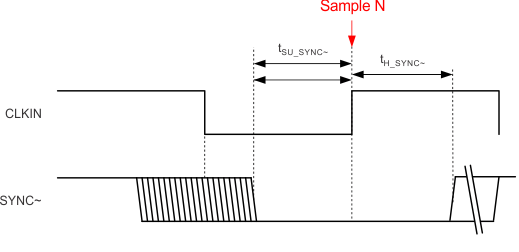 Figure 7. SYNC~ Timing (Subclass 2)
Figure 7. SYNC~ Timing (Subclass 2)
7.11 Typical Characteristics: ADS42JB46
Typical values are at TA = +25°C, ADC sampling rate = 160 MSPS, 50% clock duty cycle, AVDD = 1.8 V, AVDD3V = 3.3 V, DRVDD = 1.8 V, IOVDD = 1.8 V, –1-dBFS differential input, 2-VPP full-scale, and 64k-point FFT, unless otherwise noted.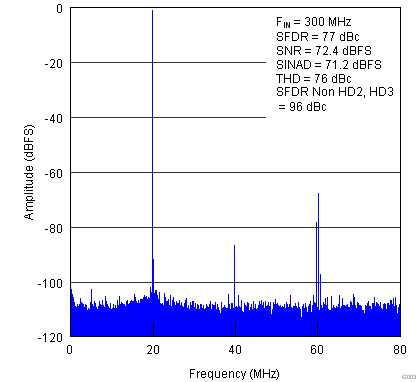 Figure 8. FFT for 300-MHz Input Signal
Figure 8. FFT for 300-MHz Input Signal
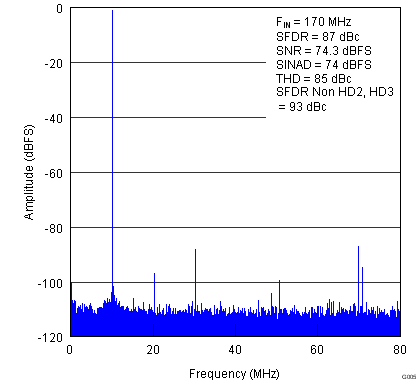 Figure 10. FFT for 170-MHz Input Signal
Figure 10. FFT for 170-MHz Input Signal (2.5-VPP Full-Scale)
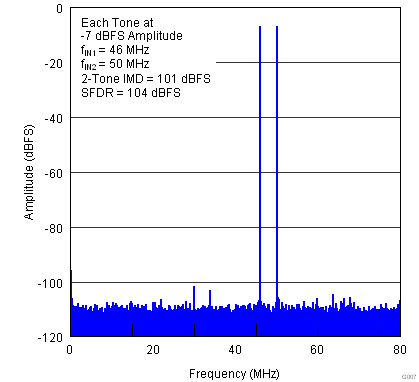 Figure 12. FFT for Two-Tone Input Signal
Figure 12. FFT for Two-Tone Input Signal(–7 dBFS at 46 MHz and 50 MHz)
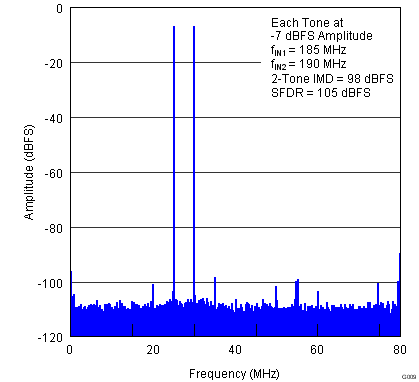 Figure 14. FFT for Two-Tone Input Signal
Figure 14. FFT for Two-Tone Input Signal(–7 dBFS at 185 MHz and 190 MHz)
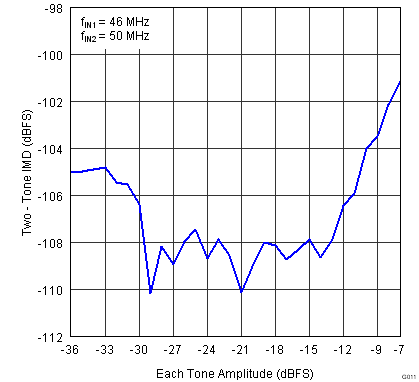 Figure 16. Intermodulation Distortion vs
Figure 16. Intermodulation Distortion vs Input Amplitude (46 MHz and 50 MHz)
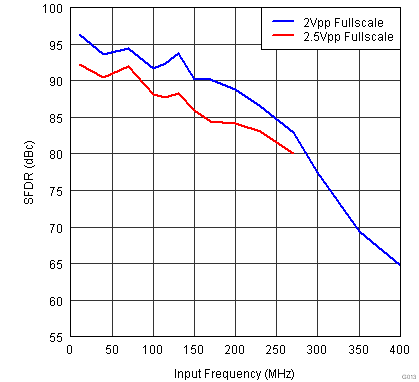 Figure 18. Spurious-Free Dynamic Range vs
Figure 18. Spurious-Free Dynamic Range vsInput Frequency
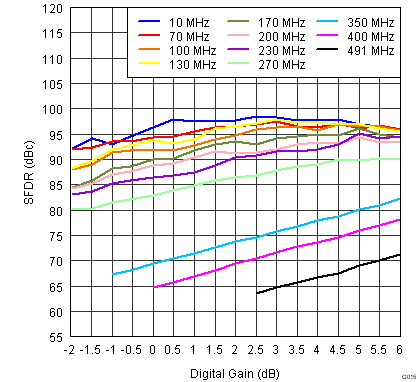 Figure 20. Spurious-Free Dynamic Range vs
Figure 20. Spurious-Free Dynamic Range vsDigital Gain
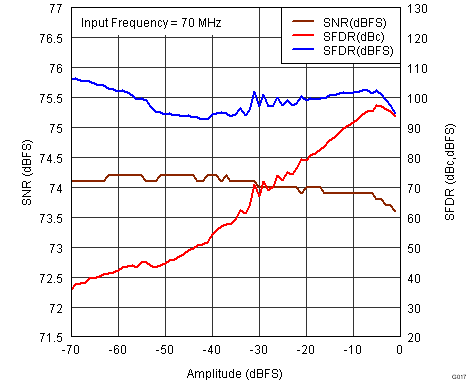 Figure 22. Performance vs Input Amplitude
Figure 22. Performance vs Input Amplitude(70 MHz)
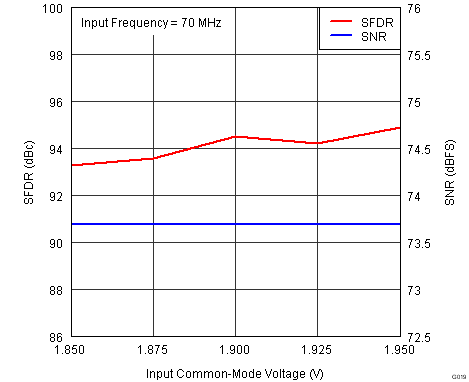 Figure 24. Performance vs
Figure 24. Performance vs Input Common-Mode Voltage (70 MHz)
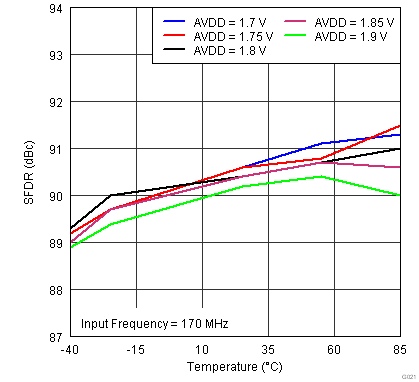 Figure 26. Spurious-Free Dynamic Range vs
Figure 26. Spurious-Free Dynamic Range vsAVDD Supply and Temperature (170 MHz)
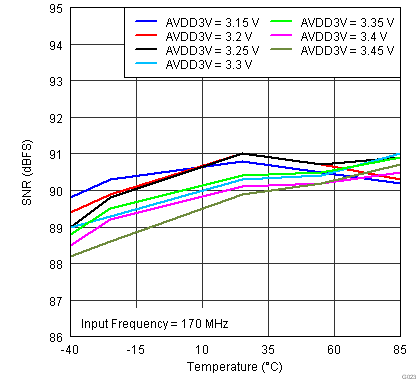 Figure 28. Spurious-Free Dynamic Range vs AVDD3V Supply and Temperature (170 Mhz)
Figure 28. Spurious-Free Dynamic Range vs AVDD3V Supply and Temperature (170 Mhz)
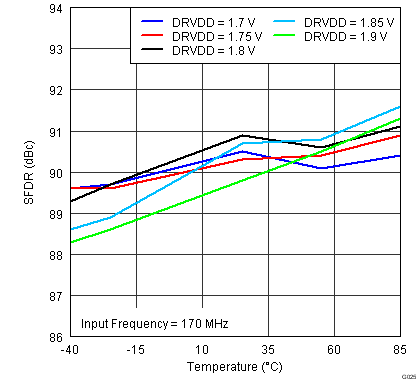 Figure 30. Spurious-Free Dynamic Range vs
Figure 30. Spurious-Free Dynamic Range vs DRVDD Supply and Temperature (170 MHz)
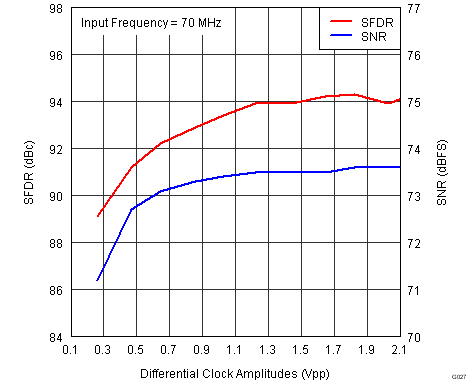 Figure 32. Performance vs Clock Amplitude
Figure 32. Performance vs Clock Amplitude (70 MHz)
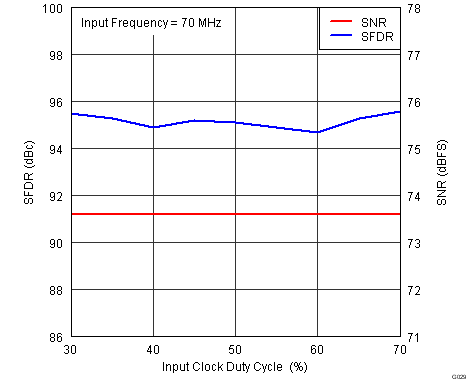 Figure 34. Performance vs Clock Duty Cycle
Figure 34. Performance vs Clock Duty Cycle(70 MHz)
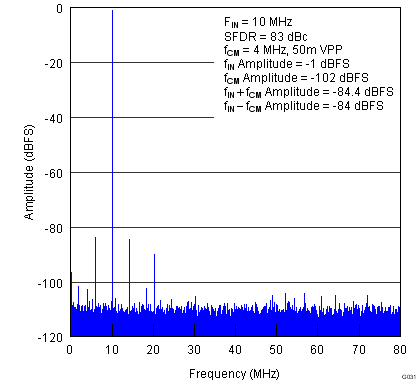 Figure 36. Common-Mode Rejection Ratio FFT
Figure 36. Common-Mode Rejection Ratio FFT
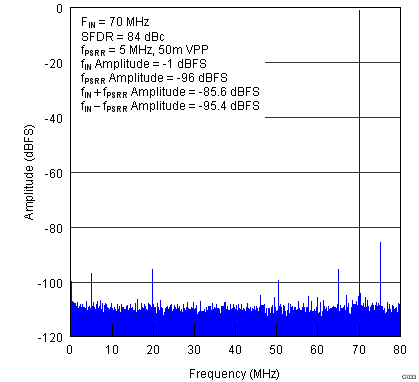 Figure 38. Power-Supply Rejection Ratio FFT for AVDD Supply
Figure 38. Power-Supply Rejection Ratio FFT for AVDD Supply
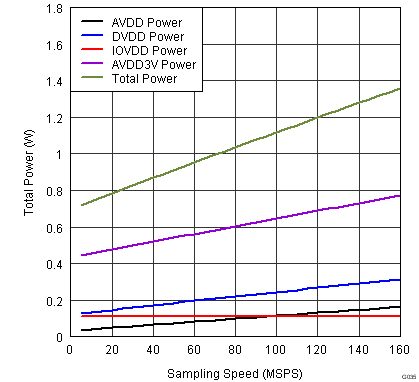 Figure 40. Total Power vs Sampling Frequency
Figure 40. Total Power vs Sampling Frequency
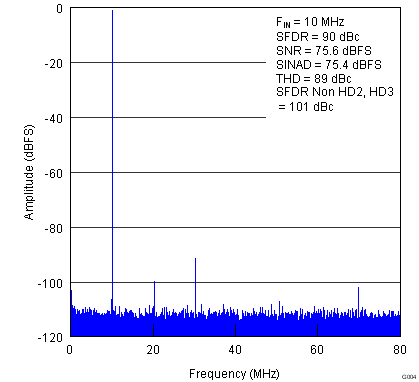 Figure 9. FFT for 10-MHz Input Signal
Figure 9. FFT for 10-MHz Input Signal(2.5-VPP Full-Scale)
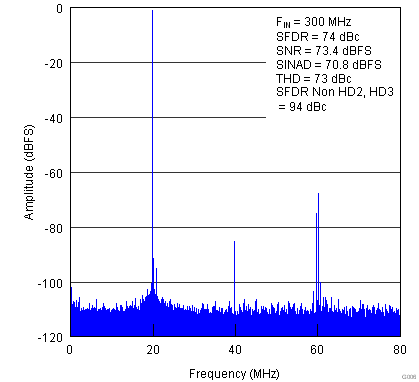 Figure 11. FFT for 300-MHz Input Signal
Figure 11. FFT for 300-MHz Input Signal (2.5-VPP Full-Scale)
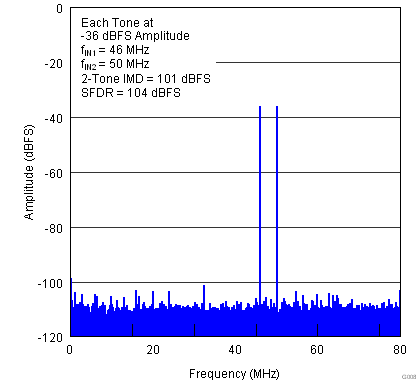 Figure 13. FFT for Two-Tone Input Signal
Figure 13. FFT for Two-Tone Input Signal(–36 dBFS at 46 MHz and 50 MHz)
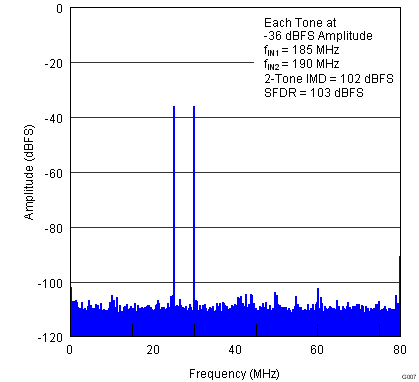 Figure 15. FFT for Two-Tone Input Signal
Figure 15. FFT for Two-Tone Input Signal(–36 dBFS at 185 MHz and 190 MHz)
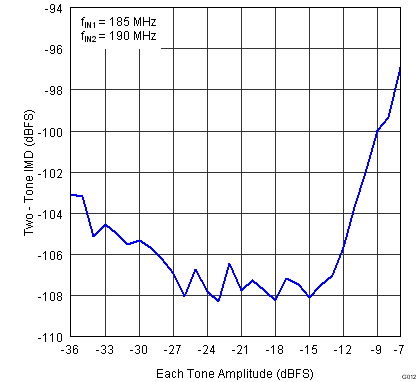 Figure 17. Intermodulation Distortion vs
Figure 17. Intermodulation Distortion vs Input Amplitude (185 MHz and 190 MHz)
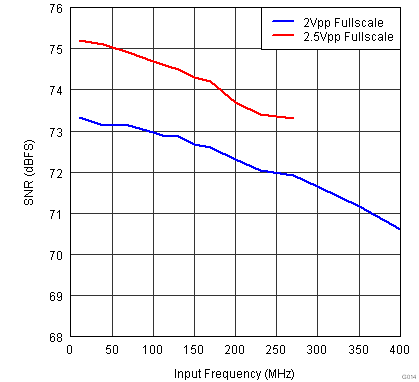 Figure 19. Signal-to-Noise Ratio vs
Figure 19. Signal-to-Noise Ratio vsInput Frequency
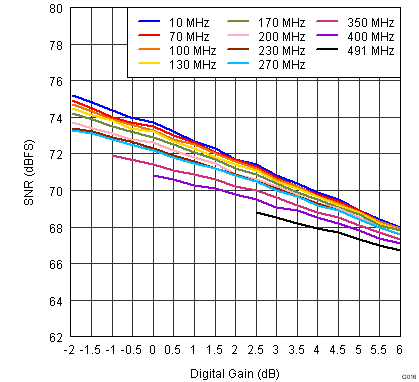 Figure 21. Signal-to-Noise Ratio vs
Figure 21. Signal-to-Noise Ratio vsDigital Gain
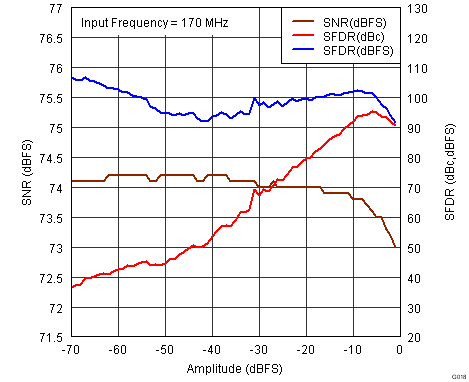 Figure 23. Performance vs Input Amplitude
Figure 23. Performance vs Input Amplitude (170 MHz)
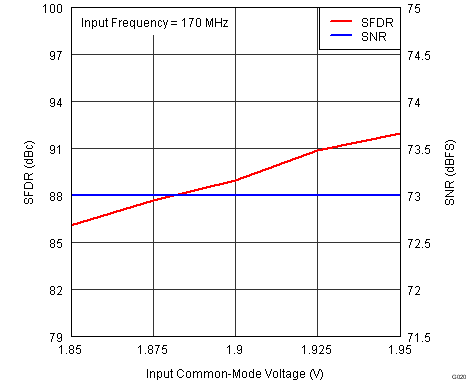 Figure 25. Performance vs
Figure 25. Performance vsInput Common-Mode Voltage (170 MHz)
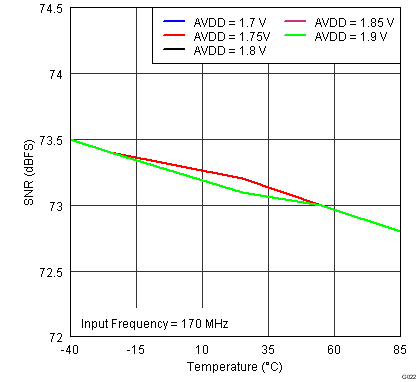 Figure 27. Signal-to-Noise Ratio vs
Figure 27. Signal-to-Noise Ratio vsAVDD Supply and Temperature (170 MHz)
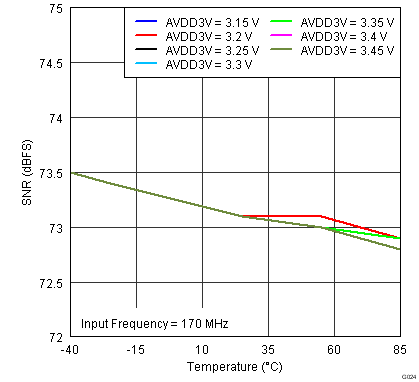 Figure 29. Signal-to-Noise Ratio vs
Figure 29. Signal-to-Noise Ratio vs AVDD3V Supply and Temperature (170 MHz)
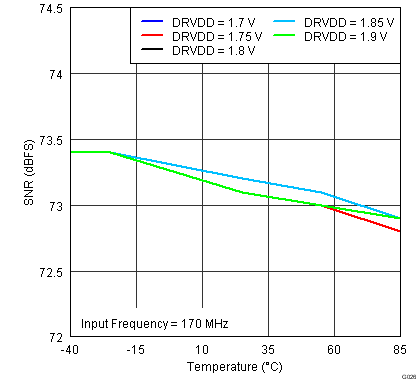 Figure 31. Signal-to-Noise Ratio vs
Figure 31. Signal-to-Noise Ratio vs DRVDD Supply and Temperature (170 MHz)
 Figure 33. Performance vs Clock Amplitude
Figure 33. Performance vs Clock Amplitude (170 MHz)
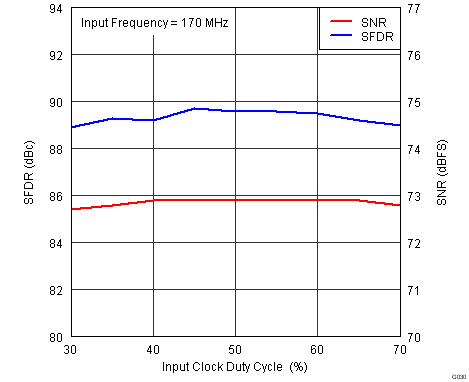 Figure 35. Performance vs Clock Duty Cycle
Figure 35. Performance vs Clock Duty Cycle (170 MHz)
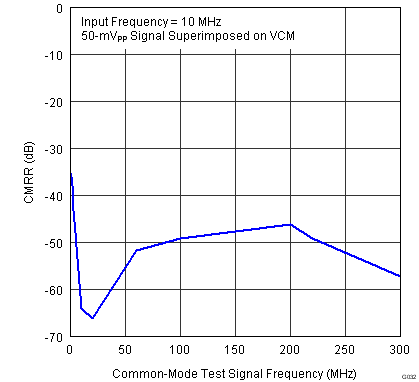 Figure 37. Common-Mode Rejection Ratio vs
Figure 37. Common-Mode Rejection Ratio vs Test Signal Frequency
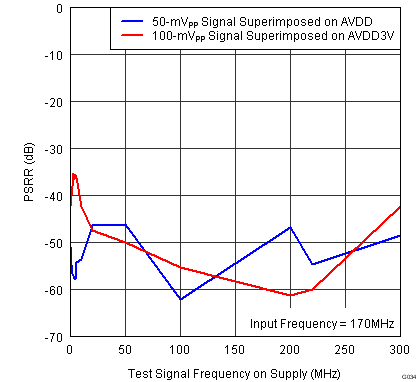 Figure 39. Power-Supply Rejection Ratio vs
Figure 39. Power-Supply Rejection Ratio vs Test Signal Frequency
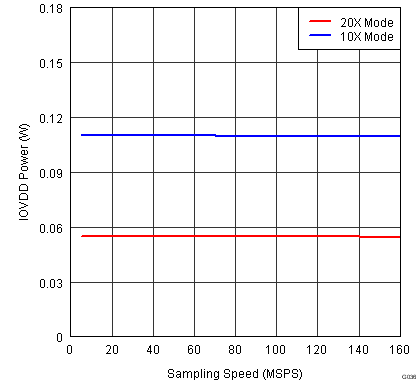 Figure 41. Analog Power vs Sampling Frequency
Figure 41. Analog Power vs Sampling Frequency
7.12 Typical Characteristics: Contour
Typical values are at TA = +25°C, full temperature range is TMIN = –40°C to TMAX = +85°C, ADC sampling rate = 160 MSPS, 50% clock duty cycle, AVDD = 1.8 V, AVDD3V = 3.3 V, DRVDD = 1.8 V, IOVDD = 1.8 V, –1-dBFS differential input, 2-VPP full-scale, and 64k-point FFT, unless otherwise noted.7.12.1 Spurious-Free Dynamic Range (SFDR)
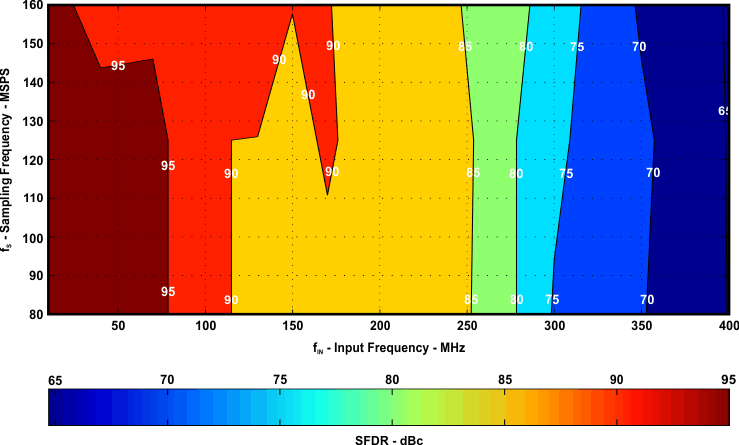 Figure 42. 0-dB Gain (SFDR)
Figure 42. 0-dB Gain (SFDR)
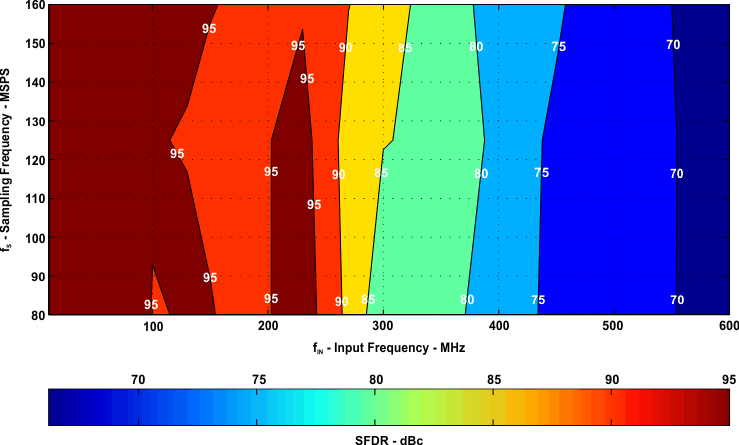 Figure 43. 6-dB Gain (SFDR)
Figure 43. 6-dB Gain (SFDR)
7.12.2 Signal-to-Noise Ratio (SNR)
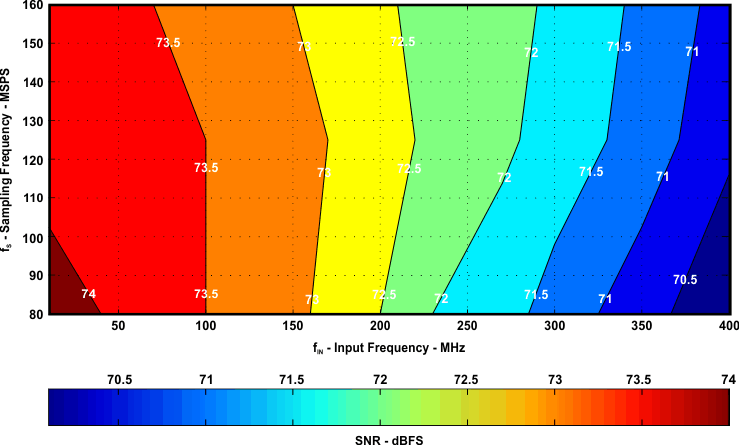 Figure 44. 0-dB Gain
Figure 44. 0-dB Gain
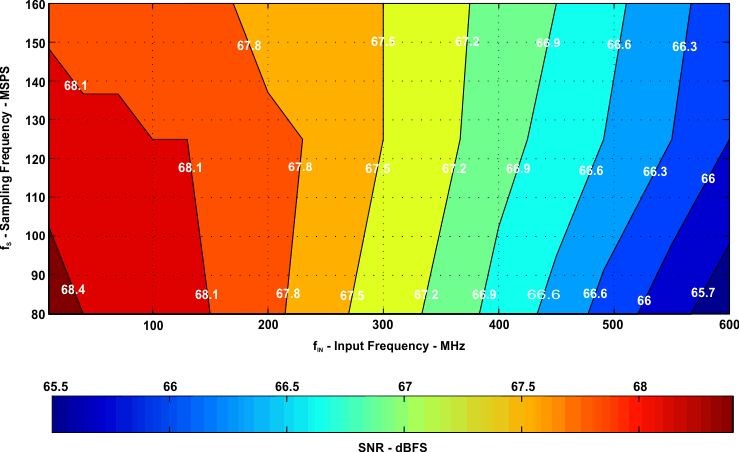 Figure 45. 6-dB Gain
Figure 45. 6-dB Gain